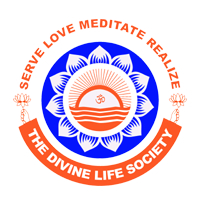Divine Life Society
This article may rely excessively on sources too closely associated with the subject, potentially preventing the article from being verifiable and neutral. (July 2023) |
 Serve, Love, Give, Purify, Meditate, Realize | |
| Formation | 1936 |
|---|---|
| Founder | Swami Sivananda |
| Type | Religious organisation |
| Legal status | Foundation |
| Purpose | Educational, Philanthropic, Religious studies, Spirituality |
| Headquarters | Rishikesh, Uttarakhand, India |
| Location |
|
Area served | Worldwide |
| Website | www |
The Divine Life Society (DLS) is a Hindu spiritual organization and an ashram, founded by Swami Sivananda Saraswati in 1936, at Muni Ki Reti, Rishikesh, India. Today Divine Life Society has branches around the world, with the headquarters situated in Rishikesh. Many disciples of Swami Sivananda have started independent organizations in Mauritius, the United States, Australia, Canada, Malaysia, South Africa, South America, and Europe.[1][2][3]
Aims
[edit]
History
[edit]In 1936, after returning from a pilgrimage, Swami Sivananda stayed in an old hut on the banks of the Ganges in Rishikesh. The King of Tehri Garhwal granted him a plot of land to construct the present day Shivanandashram.[4] Chidananda Saraswati served as president of the society from August 1963 to 28 August 2008, while Krishnananda Saraswati served as the General-Secretary of the Society in Rishikesh from 1958 until 2001.[5]
Vegetarianism
[edit]Sivananda insisted on a strict lacto-vegetarian diet for moral and spiritual reasons, arguing that "meat-eating is highly deleterious to health".[6][7][8][9] Divine Life Society thus advocates a vegetarian diet.[9]
Teachings
[edit]Sri Swami Sivananda outlined 20 important spiritual instructions for people of various religions in a book by the same name. The instructions were:
- Brahmamuhuruta: Waking up early in the morning during
- Asana: Sitting in an appropriate asana for half an hour to three hours
- Japa: recitation of a mantra
- Dietetic Discipline: Eat sattvic food
- Meditation: Have a separate meditation room or area in the home
- Swadhyay: Study religious books from half an hour to an hour daily
- Elevate the Mind: Recite shlokas before performing japa
- Brahmacharya: preservation of the vital force
- Charity
- Have Satsang: "association with holy people"
- Fast: Fast on Ekadashi or the appropriate days for one's religion
- Japa Mala: Keep a rosary and chant at every opportunity
- Observe Mouna: Be silent for a couple of hours daily
- Discipline of Speech: Speak a little, what is true, and what is sweet
- Be content: have mental detachment and share with others
- Practice Love: control anger and serve the sick and poor
- Be self-reliant
- Have self-analysis: understand one's mistakes and try to correct them
- Do your duty
- Remember God: remember God at all times[10]
The teachings of yoga are explained at length by Swami Sivananda. Yoga is "the process by which the identity of the individual soul and the Supreme Soul is realized by the Yogi."[11]
Departments
[edit]

- The headquarters for Divine Life Society is Sivananda Ashram in Uttarakhand.[12]
- Yoga-Vedanta Forest Academy trains aspirants in yoga and provides knowledge of Indian culture to develop integrity[13]
- Yoga-Vedanta Forest Academy Press prints the cultural and spiritual books as well as the journals and other literature of the Divine Life Society.
- Sivananda Publication League is the publishing arm of the Divine Life Society.
- Sivananda Charitable Hospital renders free medical service to the public and conducts periodical medical relief camps freely.[14]
See also
[edit]References
[edit]- ^ Divine Life Society Britannica.com
- ^ Divine Life Society Divine enterprise: Gurus and the Hindu Nationalist Movement, by Lise McKean. University of Chicago Press, 1996. ISBN 0-226-56009-0. Page 164=165.
- ^ Swami Shivananda Religion and anthropology: a critical introduction, by Brian Morris. Cambridge University Press, 2006. ISBN 0-521-85241-2. Page 144.
- ^ Introduction Archived 26 October 2006 at the Wayback Machine
- ^ "His Holiness Sri Swami Krishnananda Saraswati Maharaj – The Divine Life Society". www.dlshq.org.
- ^ Rosen, Steven. (2011). Food for the Soul: Vegetarianism and Yoga Traditions. Praeger. p. 22. ISBN 978-0313397035
- ^ McGonigle, Andrew; Huy, Matthew. (2022). The Physiology of Yoga. Human Kinetics. p. 169. ISBN 978-1492599838
- ^ "Meat-Eating". sivanandaonline.org. Retrieved 22 January 2023.
- ^ a b "Vegetarianism". dlshq.org. Retrieved 22 January 2023.
- ^ "20 Important Spiritual Instructions – The Divine Life Society". Retrieved 28 May 2023.
- ^ "Yoga – The Divine Life Society". Retrieved 3 April 2023.
- ^ "The Divine Life Society - Member Institutions of Indian Yoga Association". Indian Yoga Association. Retrieved 4 May 2023.
- ^ "The Divine Life Society – The Divine Life Society". Retrieved 26 March 2023.
- ^ "Sivananda Charitable Hospital". www.sivanandaonline.org. Retrieved 26 March 2023.
Further reading
[edit]- Ananthanarayanan, N. (1970). From man to God-man: the inspiring life-story of Swami Sivananda. Indian Publ. Trading Corp.
- Fornaro, Robert John (1969). Sivananda and the Divine Life Society: A Paradigm of the "secularism," "puritanism" and "cultural Dissimulation" of a Neo-Hindu Religious Society. Syracuse University.
- Gyan, Satish Chandra (1979). Swami Sivananda and the Divine Life Society: An Illustration of Revitalization Movement. s.n.[clarification needed].


 French
French Deutsch
Deutsch